|
|
|
Harold Sailsbury -
The Charles W Morgan
|
|
|
SAIL or SINK !
Over the last fifteen years or so I have constructed several scaled (1:50)
model tall ships among them being The Charles W Morgan, The Great Harry,
Thermopylae and The Pandora. They were all built from kits purchased from
model shops and they were for display purposes only. None of them were
built to sail. As this is the last time I shall ever build another model
tall ship I have decided to make The Charles W Morgan again but
with a significant difference.
I will not be buying a kit
as much material as possible will be supplied by myself, see specs below.
Also every part e.g. yards, yardarms as well as any fittings on deck will
be fully jointed and function but the most important difference will be
that it will sail, or so I hope it does. The test run on completion will
take place in a wild life pond near to where I live. If I am successful,
all well and good, but if the ship sinks when I launch it then tough.
Plans.
From my original purchase of the kit in 1990 approx.
Materials.
False keel. Any old plywood I can find at home.Masts, yardarms, davits,
steps, keel, rudder and all deck fittings will be made from wood salvaged
from our old front door. All deck planking and canopy planking will be
made from my stock of wood veneers. All metal fittings, hinges, yard
trusses and anchors will be made from 0.5 mm, 1mm, 2mm, or 3mm thick brass
plate. All doors will open and close, the same will apply to all fully
jointed drawers. All timber structures will be fully jointed where ever
possible and hopefully all yardarms and yards will be fully functional.
All yards will be hand stitched and made from material scrounged from my
wife's sewing room. I do not have any information about the specifications
for the yards so everything in this department will be guess work at best.
I do not have any
information about ballast for the ship so again everything in this
department will be guess work.
Material to be purchased.
Deadeyes, belaying pins, brass eyelets and pins, block and tackle, brass
rings and chain and cotton. Everything will be hand made and the only
power tools I will use will be: 1 electric drill, 1 mini drill and an
obsolete band saw.
Each operation successful or not will be recorded and that also goes for
the launching, whether the ship sails or not, I have nothing to hide.
I have allowed myself approximately 14 months in which to complete this
project so here goes.
There is just one point I want to make before I continue. At the time I
started on this idea I did not have a digital camera so some earlier
Pictures were taken from another camera until such time as I had my own.
(MARCH 2005)Also I did not own a computer. I bought on in April 2005 which
led to another problem, Iím not computer literate, I donít have much
patience with electronics and its been a hard slog getting my knowledge up
to this level hence the reason for the delay in transferring my records on
to this screen until the 12th October 2005.Even so nothing has been lost
so its catch up time for the next week or so. Then I have to learn how to
get a web page. I think I will be calling on the expertise of others again
|
|
Photo of some of the materials
used. 
|
|
FEBRUARY
2005
Work starts on the false keel. No problems
here cutting and shaping the plywood to form the false keel and deck. Once
all parts were in place and the edges chamfered to take the first layer of
hull planking I decided to see how it would float. After securely wrapping
the unit in polythene I placed it in a bath full of cold water. Oops it
turned over which is what I expected it to do. Ballast required but what
could I use, at this stage I hadnít a clue. There was no rush to solve the
problem as I had plenty of other things to do such as plank the deck.
Using veneer of 1mm thick I cut a sheet into 6mmwide strips with each
strip being reduced to 130mm in length. Any length not to these specs were
thrown away as there had to be no gaps between the strips when glued into
position. All edges were coloured black using an indelible marker to give
the effect of tar sealing between the planks.
March 2005.
Still not solved the problem of ballast and
planking to the deck was finished. The next stage should be first stage
planking to the hull but I will have to put this on hold until such time
as I am ready. Meanwhile I decided to buy extra time by dowelling the
planking of the deck.2 1.5mm dowels per plank width set at 130mm
intervals, which should keep me out of trouble for a while. First of all I
had to make a dowel maker of 1.5mm diameter and 2 hours later I was ready
for action and making hundreds of small dowels and drilling holes in the
deck. Once the
Glue had
set the waste was trimmed off and surface smoothed down.
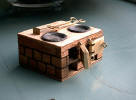
 |
|
April 2005.
Still nowhere near to solving the problem of ballast so
I continued to make some more parts and fittings starting with the masts.
Unfortunately the hard wood I was using was of a very poor quality and was
proving difficult to taper the wood down to the correct diameter (very
weak and soon snapped).A slightly thicker taper solved the problem.
The scrap lead flashing I found in my shed could be put
to another use besides the vats on the Rending furnace. BALLAST for the
boat itself. Cutting it down into equal widths and lengths the lead was
nailed to the sides of the plywood sections of the false keel. Back to the
bathroom for a test run. It worked, steady as a rock. Even after swishing
the water about the hull remained upright and soon steadied itself. My
only doubt was the weight of the ballast; would it be too heavy or too
light as progress on the boat neared its final stages? |
|
 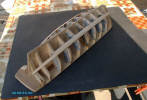 
MAY 2005
Of other things to do
such as plank the deck. Using veneer of 1mm thick I cut a sheet into
6mmwide strips with each strip being reduced to 130mm in length. Any
length not to these specs were thrown away as there had to be no gaps
between the strips when glued into position. All edges were coloured black
using an indelible marker to give the effect of tar sealing between the
planks.
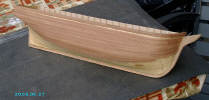 

|
|
JUNE 2005
Both first and second layers
of planking are finished and there are no gaps to fill in on either layer,
I never have any trouble with these operations. Holes are drill to
accommodate the three masts.
|
|

|
 |
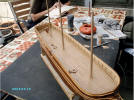 |
 |
|
Masts, ships wheel and rudder
installed,
all spot on.
|
Front of hurricane house added, note dowelling to deck planks. Looks like
I will have to do those mast pin rails again, they are a bit Skewy eyed.
Doors open and close.
|
|
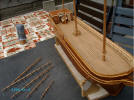 |
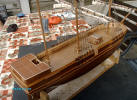 |
|
Hurricane house finished, steps and handrail, new mast pin rails and
added bowsprit, workbench, rending furnace, shroud ratlines of main
and
Belaying pins,
some yards partly prepared.
|
And fore mast. The roof to the
hurricane house is a different colour to the Planking of the rest of the
boat as it highlights the dowelling a lot better.
|
|
 |
 |
|
Lines were sewn onto a piece of white cotton four feet
by four feet to give the impression of each sail being made up of
individual sections. All hems were blanket
stitched as I believe they would have been at that time
in history whereas bought sails are overlooked (if I
could have got them for this boat).
|
The windows to the rear of the hurricane house are jointed with clear
polythene as glass. The units are inserted and fit flush though they do
not Function. |
July 2005.
|
|
 |

|
Boom and gaff. The brass
fittings are set into a rebate, glued and nailed Dowelling to one of the
canopies.
In place. |
Blurred photo of two different types of
drawers. |
|
 |
 |
|
Rat lines, yard arms and yards to main and
fore mast |
Above: Fore companion way- door actually locks, a
primitive method -
It works. Sliding section to canopy to give extra headroom.
|
|
 |
 |
|
Close up showing rending furnace complete with stoking
tools. Workbench, ratlines and hinged gate.
|
Partly finished Windlass-still to do- ratchet and
brakes. At this stage I havenít worked out how to make them.
|
|
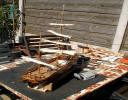 |
 |
After seven months work all seems to be going well but the big test
will come when I test the boat for buoyancy in water. I have every
confidence of overcoming any difficulties.
|
|
Home
|